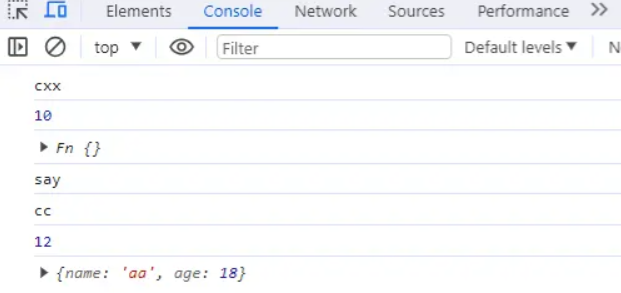实现New
- 首先创建一个新的空对象
- 设置原型,将对象的原型设置为函数的prototype对象
- 让函数的this指向这个对象,执行构造函数的代码
- 判断函数的返回值类型,如果是值类型,返回创建的对象。如果是引用类型,就返回这个引用类型的对象
function myNew(constructor, ...args) {
// 如果不是一个函数,就报错
if (typeof constructor !== "function") {
throw "myNew function the first param must be a function";
}
// 基于原型链 创建一个新对象,继承构造函数constructor的原型对象上的属性
let newObj = Object.create(constructor.prototype);
// 将newObj作为this,执行 constructor ,传入参数
let res = constructor.apply(newObj, args);
// 判断函数的执行结果是否是对象,typeof null 也是'object'所以要排除null
let isObject = typeof res === "newObject" && res !== null;
// 判断函数的执行结果是否是函数
let isFunction = typeof res === "function";
// 如果函数的执行结果是一个对象或函数, 则返回执行的结果, 否则, 返回新创建的对象
return isObject || isFunction ? res : newObj;
}
// 用法
function Person(name, age) {
this.name = name;
this.age = age;
// 如果构造函数内部,return 一个引用类型的对象,则整个构造函数失效,而是返回这个引用类型的对象
}
Person.prototype.say = function() {
console.log(this.age);
};
let p1 = myNew(Person, "poety", 18);
console.log(p1.name); //poety
console.log(p1); //Person {name: 'poety', age: 18}
p1.say(); //18
测试结果:

call、apply、bind
实现call
思路:接受传入的context上下文,如果不传默认为window,将被调用的方法设置为上下文的属性,使用上下文对象来调用这个方法,删除新增属性,返回结果。
//写在函数的原型上
Function.prototype.myCall = function (context) {
// 如果要调用的方法不是一个函数,则报错
if (typeof this !== "function") {
throw new Error("Type error");
}
// 判断 context 是否传入,如果没有传就设置为 window
context = context || window;
// 获取参数,[...arguments]把类数组转为数组
let args = [...arguments].slice(1);
let result = null;
// 将被调用的方法设置为context的属性,this即为要调用的方法
context.fn = this;
// 执行要被调用的方法
result = context.fn(...args);
// 删除手动增加的属性方法
delete context.fn;
// 将执行结果返回
return result;
};
//测试
function f(a, b) {
console.log(a + b);
console.log(this.name);
}
let obj = {
name: 1,
};
f.myCall(obj, 1, 2); // 3,1
测试结果:

实现apply
思路:除了传参方式是数组,其它与call没区别
Function.prototype.myApply = function (context) {
if (typeof this !== "function") {
throw new Error("Type error");
}
let result = null;
context = context || window;
// 与上面代码相比,我们使用 Symbol 来保证属性唯一,也就是保证不会重写用户自己原来定义在 context 中的同名属性
const fnSymbol = Symbol();
context[fnSymbol] = this;
// 执行要被调用的方法,处理参数和 call 有区别,判断是否传了参数数组
if (arguments[1]) {
//传了参数数组
result = context[fnSymbol](...arguments[1]);
} else {
//没传参数数组
result = context[fnSymbol]();
}
delete context[fnSymbol];
return result;
};
//测试
function f(a, b) {
console.log(a, b);
console.log(this.name);
}
let obj = {
name: "张三",
};
f.myApply(obj, [1, 2]); //1 2,张三
测试结果:

实现bind
思路:bind返回的是一个函数,需要判断函数作为构造函数的情况,当作为构造函数时,this指向实例,不会被任何方式改变this,所以要忽略传入的context上下文。
bind可以分开传递参数,所以需要将参数拼接。如果绑定的是构造函数,还需要继承构造函数原型上的属性和方法,保证不丢失。
Function.prototype.myBind = function (context) {
// 判断调用对象是否为函数
if (typeof this !== "function") {
throw new Error("Type error");
}
// 获取参数
const args = [...arguments].slice(1);
const fn = this; // 保存this的值,代表调用bind的函数
//返回一个函数,此函数可以被作为构造函数调用,也可以作为普通函数调用
const Fn = function () {
// 根据调用方式,传入不同绑定值
// 当作为构造函数时,this 指向实例,不会被任何方式改变 this,要忽略传入的context上下文
return fn.apply(
this instanceof Fn ? this : context,
// bind可以分开传递参数(如f.bind(obj, 1)(2)),所以需要将参数拼接,这里使用apply,参数拼接成一个数组
args.concat(...arguments)//当前的这个 arguments 是指 Fn 的参数,也可以用剩余参数的方式
);
};
//对于构造函数,要保证原函数的原型对象上的属性不能丢失
Fn.prototype = Object.create(fn.prototype);
return Fn;
};
// 1.先测试作为构造函数调用
function Person(name, age) {
console.log(name);
console.log(age);
console.log(this); //构造函数this指向实例对象
}
// 构造函数原型的方法
Person.prototype.say = function () {
console.log("say");
};
var obj = {
name: "cc",
age: 18,
};
var bindFun = Person.myBind(obj, "cxx");
var a = new bindFun(10);
// cxx
// 10
// Person {}
a.say(); // say
// 2.再测试作为普通函数调用
function normalFun(name, age) {
console.log(name);
console.log(age);
console.log(this); // 普通函数this指向绑定bind的第一个参数 也就是例子中的obj
}
var obj = {
name: "aa",
age: 18,
};
var bindNormalFun = normalFun.myBind(obj, "cc");
bindNormalFun(12);
// cc
// 12
// { name: 'aa', age: 18 }
测试结果:

防抖和节流
防抖
防抖是指在事件被触发n秒后在执行回调,如果在这n秒内时间又被触发,则重新计时。
可以使用在一些点击请求的事件上,避免因为用户的多次点击向后端发送多次请求。
//fn是需要防抖的函数,delay是等待时间
function debounce(fn, delay = 500) {
let timer = null;
// 这里返回的函数是每次用户实际调用的防抖函数
return function(...args) { //...args是es6的剩余参数语法,将多余的参数放入数组,用来代替arguments对象
// 如果已经设定过定时器了就清空上一次的定时器
if(timer) {
clearTimeout(timer);
}
// 开始一个新的定时器,延迟执行用户传入的方法;注:定时器的返回值是一个数值,作为定时器的编号,可以传入clearTimeout来取消定时器
timer = setTimeout(() => { //这里必须是箭头函数,不然this指向window,要让this就指向fn的调用者
fn.apply(this, args);
}, delay)
}
}
节流
节流就是一定时间内执行一次事件,即使重复触发,也只有一次生效。
可以使用在监听滚动scroll事件上,通过事件节流来降低事件调用的频率。
定时器版本
throttle(fn, delay = 500) {
let timer = null;
return function(...args) {
// 当前有任务了,直接返回
if(timer) {
return;
}
timer = setTimeout(() => {
fn.apply(this, args);
//执行完后,需重置定时器,不然timer一直有值,无法开启下一个定时器
timer = null;
}, delay)
}
}
时间戳版本
// 节流
function throttle(fn, delay = 500) {
let prev = Date.now();// 上一次执行该函数的时间
return function(...args) {
let now = Date.now();//返回从UTC到当前时间的毫秒数
// 如果差值大于等于设置的等待时间就执行函数
if (now - prev >= delay) {
fn.apply(this, args);
prev = Date.now();
}
};
}
实现instanceof
instanceof用于检测构造函数的prototype属性是否出现在某个实例对象的原型链上。
myInstanceof(instance, constructor) {
//如果不是对象,或者是null,直接返回false
if (typeof instance !== "object" || instance === null) {
return false;
}
// 获取对象的原型
let proto = Object.getPrototypeOf(instance);
// 获取构造函数的 prototype 对象
let prototype = constructor.prototype;
// 判断构造函数的 prototype对象是否在对象的原型链上
while (true) {
// 到达原型链终点null,说明没找到
if (!proto) {
return false;
}
if (proto === prototype) {
return true;
}
// 如果没有找到,就继续从其原型上找
proto = Object.getPrototypeOf(proto);
}
}
//测试
let Fn = function () { }
let p1 = new Fn()
console.log(myInstanceof(p1, Fn));//true
console.log(myInstanceof([], Fn));//false
console.log(myInstanceof([], Array)) // true
console.log(myInstanceof(function(){}, Function)) // true
测试结果:

实现Ajax
创建一个XMLHttpRequest对象
在这个对象上使用open方法创建一个HTTP请求(参数为请求方法、请求地址、是否异步和用户的认证信息)
通过send方法来向服务器发起请求(post请求可以入参作为发送的数据体)
监听请求成功后的状态变化:根据状态码进行相应的出来。onreadystatechange设置监听函数,当对象的readyState变为4的时候,代表服务器返回的数据接收完成,这个时候可以通过判断请求的状态,如果状态是200则为成功,404或500为失败。
function ajax(url) {
//1.创建XMLHttpRequest对象
const xhr = new XMLHttpRequest();
//2.使用open方法创建一个GET请求
xhr.open('GET',url);
//xhr.open('GET',url,true);//true代表异步,已完成事务的通知可供事件监听器使用;如果为false,send() 方法直到收到答复前不会返回
//3.发送请求
xhr.send();
//4.监听请求成功后的状态变化(readyState改变时触发):根据状态码(0~5)进行相应的处理
xhr.onreadystatechange = function () {
//readyState为4代表服务器返回的数据接收完成
if (xhr.readyState == 4) {
//请求的状态为200或304代表成功
if(xhr.status == 200 || xhr.status == 304) {
//this.response代表返回的数据
handle(this.response);
} else {
//this.statusText代表返回的文本信息
console.error(this.statusText);
}
}
};
}
使用Promise封装Ajax:
function ajax(url) {
return new Promise((resolve, reject) => {
let xhr = new XMLHttpRequest()
xhr.open('get', url)
xhr.send()
xhr.onreadystatechange = () => {
if (xhr.readyState == 4) {
if (xhr.status == 200 || xhr.status == 304) {
resolve(this.response)
} else {
reject(new Error(this.statusText));
}
}
}
})
}
//使用
let url = '/data.json'
ajax(url).then(res => console.log(res))
.catch(reason => console.log(reason))




















 150
150











 被折叠的 条评论
为什么被折叠?
被折叠的 条评论
为什么被折叠?








